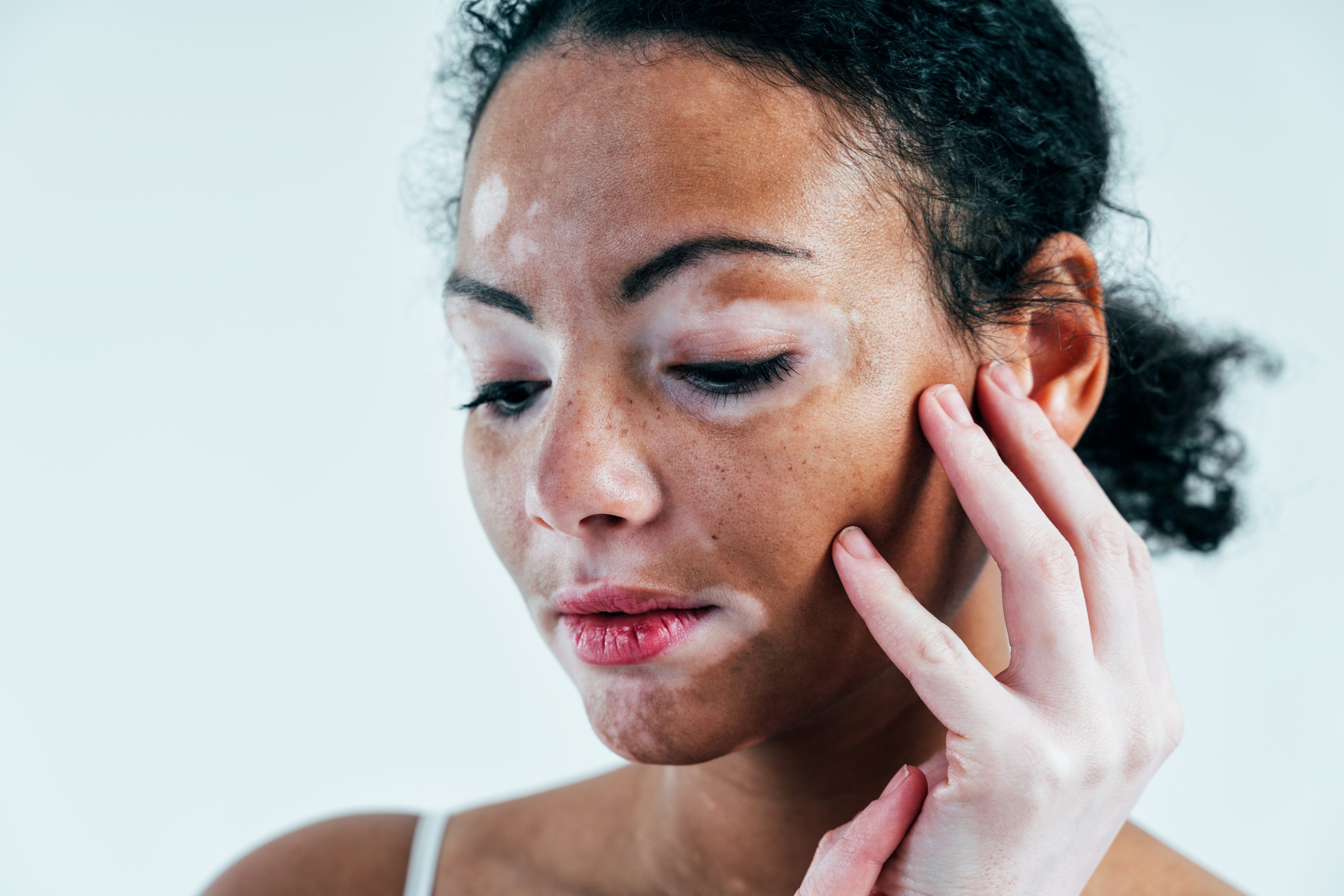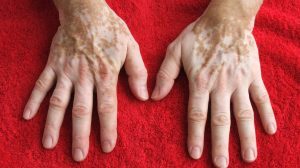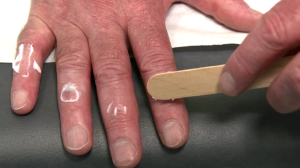
 For a long time, vitiligo was considered purely a cosmetic issue, but the disease often causes significant stress for those affected. What effective therapies are available? Increased public acceptance, exemplified by models like Winnie Harlow, has brought vitiligo to international catwalks. The development of new therapies and active ingredients provides hope for vitiligo patients in achieving a better quality of life.
For a long time, vitiligo was considered purely a cosmetic issue, but the disease often causes significant stress for those affected. What effective therapies are available? Increased public acceptance, exemplified by models like Winnie Harlow, has brought vitiligo to international catwalks. The development of new therapies and active ingredients provides hope for vitiligo patients in achieving a better quality of life.
Tedious and individual: Treatment of vitiligo
Vitiligo is a chronic skin disease where the body’s own immune system attacks the pigment-forming cells. Treating vitiligo has long been considered challenging and unpredictable in dermatology. Patients who visited dermatologists with this condition were often met with shrugs and the information that nothing could be done. However, this is no longer the case today. “We can now treat vitiligo much more effectively, thanks to recent years’ important insights into the disease’s development and causes.” – Prof. Dr. Michael Sticherling, Deputy Clinic Director, Dermatology Clinic, University Hospital Erlangen.
Doctors use black light to visualize the areas of skin where the pigment-forming cells have been mostly or completely destroyed. The cause is likely an overreaction of the immune system in combination with hypersensitivity to oxygen radicals. The exact causes are not entirely clear, and it is probably an interaction of various processes that differ among patients.
 The causes of vitiligo are diverse, and there are different theories. One theory suggests an autoimmune reaction, where the body’s defense system targets the melanocytes, the pigment cells of the skin. Another theory suggests a disrupted redox ratio, meaning an imbalanced oxygen radical ratio in the melanocytes, as a significant factor. There is also a theory that suggests increased melanocyte migration, as well as a theory that combines all three factors. It is likely that all three theories hold some truth and may vary in importance and relevance among different patients.” – Prof. Dr. Michael Sticherling, Deputy Clinic Director, Dermatology Clinic, University Hospital Erlangen.
The causes of vitiligo are diverse, and there are different theories. One theory suggests an autoimmune reaction, where the body’s defense system targets the melanocytes, the pigment cells of the skin. Another theory suggests a disrupted redox ratio, meaning an imbalanced oxygen radical ratio in the melanocytes, as a significant factor. There is also a theory that suggests increased melanocyte migration, as well as a theory that combines all three factors. It is likely that all three theories hold some truth and may vary in importance and relevance among different patients.” – Prof. Dr. Michael Sticherling, Deputy Clinic Director, Dermatology Clinic, University Hospital Erlangen.
Differently effective: Therapies for vitiligo
Cortisone, an active ingredient that suppresses the immune system, can be used for external treatment of vitiligo. However, due to its side effects, it should not be used as a long-term therapy. “The effectiveness of cortisone varies greatly, with some patients responding well, and different body regions responding differently. The main problem with cortisone usage lies in its side effects, such as skin thinning and increased susceptibility to infections. In the case of a chronic disease like vitiligo, long-term cortisone therapy is not justifiable.” – Prof. Dr. Michael Sticherling, Deputy Clinic Director, Dermatology Clinic, University Hospital Erlangen.
Another possible active ingredient for external use is known as calcineurin inhibitors: “Calcineurin inhibitors also have an immunological effect. Some smaller studies have shown effectiveness, particularly in combination with UVB light. However, the effectiveness is not 100 percent, and it does not work for all patients.” – Prof. Dr. Michael Sticherling, Deputy Clinic Director, Dermatology Clinic, University Hospital Erlangen.
Vitiligo therapy often involves a trial-and-error approach to find what works best for each individual patient. It requires patience and perseverance until the therapy is successful. This also applies to phototherapy, which includes local irradiation with UVB light or whole-body phototherapy. The short-wave light is intended to stimulate the formation of new pigment cells. “We also use UVB light for other skin diseases, but it should be viewed critically due to its potential to promote skin aging and even the development of skin cancer. This is an important consideration that needs to be taken into account for vitiligo patients
“We also use UVB light for other skin diseases, but it should be viewed critically due to its potential to promote skin aging and even the development of skin cancer. This is an important consideration that needs to be taken into account for vitiligo patients.” – Prof. Dr. Michael Sticherling, Deputy Clinic Director, Dermatology Clinic, University Hospital Erlangen.
New therapies: JAK inhibitors in vitiligo
 Prof. Sticherling is currently researching new active ingredients called JAK inhibitors. These drugs can suppress the specific immune system dysfunction in the skin of vitiligo patients, although not all patients respond to them. “This group of drugs, or active ingredients, was discovered more or less by accident while treating other diseases, particularly serious tumor diseases. It was found that vitiligo, coincidentally present at the same time, decreased under the therapy. Only then were these drugs further developed.” – Prof. Dr. Michael Sticherling, Deputy Clinic Director, Dermatology Clinic, University Hospital Erlangen.
Prof. Sticherling is currently researching new active ingredients called JAK inhibitors. These drugs can suppress the specific immune system dysfunction in the skin of vitiligo patients, although not all patients respond to them. “This group of drugs, or active ingredients, was discovered more or less by accident while treating other diseases, particularly serious tumor diseases. It was found that vitiligo, coincidentally present at the same time, decreased under the therapy. Only then were these drugs further developed.” – Prof. Dr. Michael Sticherling, Deputy Clinic Director, Dermatology Clinic, University Hospital Erlangen.
JAK Inhibitors
Janus kinase inhibitors include several active ingredients used for autoimmune diseases, among other conditions. In March 2023, the European Medicines Agency (EMA) and the Federal Institute for Drugs and Medical Devices (BfArM) published a warning letter for some of these active ingredients in coordination with the manufacturers. This update provides information on warnings and precautionary measures for the use of already approved drugs containing these active ingredients. (Reference)

A new cream with a JAK inhibitor was recently approved in the EU and will be covered by statutory health insurance companies. Georg Pliszewski from the Vitiligo self-help organization “Deutscher Vitiligo-Bund e.V.” expressed his thoughts
 “It definitely marks a new chapter in vitiligo therapy, as it has just been approved in Germany and Europe. However, we are yet to determine the side effects of this new product, this new cream. It will be the responsibility of doctors, particularly dermatologists prescribing the cream, to monitor their patients.”-Georg Pliszewski, German Vitiligo Federation e.V.
“It definitely marks a new chapter in vitiligo therapy, as it has just been approved in Germany and Europe. However, we are yet to determine the side effects of this new product, this new cream. It will be the responsibility of doctors, particularly dermatologists prescribing the cream, to monitor their patients.”-Georg Pliszewski, German Vitiligo Federation e.V.
Research into new active ingredients has stimulated studies on vitiligo, its causes, and potential therapies. This represents a positive development for Georg Pliszewski. However, the decision regarding therapy, whether to pursue it or not, remains a careful consideration for patients in consultation with their doctors.
Many affected individuals have had positive experiences with psychotherapeutic support and engaging with other patients in self-help organizations.”
Credit for all Images : Bild:BR




